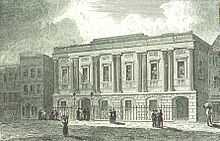Birmingham Street Commissioners
The Birmingham Street Commissioners were created in Birmingham, England by the Birmingham Improvement Act 1769 (Long title: An Act for the laying open and widening certain ways and passages within the Town of Birmingham, and for cleansing and lighting the streets, ways, lanes, and passages there, and for removing and preventing nuisances and obstructions therein.).[1] Subsequent Improvement Acts of 1773, 1801, and 1812 gave increased powers to the Street Commissioners. In 1812, they became responsible for the repair and drainage of roads.
The Street Commissioners (elsewhere also called Improvement Commissioners or Pavement Commissioners) were given the power to ensure clean streets and to provide lighting by oil lamps. Roads could also be widened by the demolition of buildings and removal of cellar entrances.
Members
The Board of Street Commissioners consisted of fifty residents, unpaid, each of whom owned property with a rateable value of over fifteen pounds. They included Sampson Lloyd (banker), John Taylor (banking partner of Sampson Lloyd), Dr. John Ash (founder of the General Hospital), and John Baskerville (printer). Replacement commissioners were chosen by the commissioners themselves.
Roads
The 1773 Act gave powers for the widening of Moor Street, Smallbrook Street, New Street and parts of Colmore Row (previously called Ann street).[1]
Markets
One of their early targets was the control and reorganisation of the markets, moving them towards the area now known as the Bull Ring. In 1817, the Smithfield Market was created on the moat of the old manor house. This handled cattle, horses, sheep, pigs, hay and straw.
In 1824, they purchased the Manor and rights to the markets from the lord of the manor.
The Market Hall was opened in 1835 for general merchandise. It was destroyed by bombs in World War II.
Policing
The commissioners were empowered to appoint watchmen, but had insufficient funds. In 1783, the commissioners were supervising private watchmen who looked after specific properties. In December 1789, thirty winter night watchmen were appointed, this number being increased in 1797, 1798, and 1801. By 1830, the watchmen covered the day as well.
Building works

The Public Office, designed by William Hollins, was built in Moor Street in 1806 encompassing offices for the Street Commissioners, magistrates' courts and a prison.
In 1818, some streets were lit by gas, replacing the oil lamps which had been used from 1780.
In 1834, the Birmingham Town Hall was built.
Demise
The Municipal Corporations Act 1835 led to the first elected councils. Birmingham was incorporated in 1838 and the new corporation worked alongside the Street Commissioners.
In 1851, a new Birmingham Improvement Act gave Birmingham Corporation the functions of the Street Commissioners.
See also
References
- ↑ 1.0 1.1 Dent, Robert Kirkup (1894). The Making of Birmingham: Being a History of the Rise and Growth of the Midland Metropolis. J. L. Allday. p. 133+. Retrieved 1 January 2014.
- Localhistories.org - A Brief History Of Birmingham
- 'Economic and Social History: Markets and Fairs', A History of the County of Warwick: Volume 7: The City of Birmingham (1964), pp. 251-52.
- The Real History of Birmingham, Volume 2, J. P. Lethbridge, Newgate Press, 2002, ISBN 0-9512227-8-3
- Birmingham Buildings, The Architectural Story of a Midland City, Bryan Little, 1971, ISBN 0-7153-5295-4